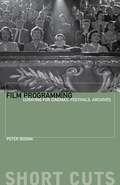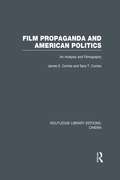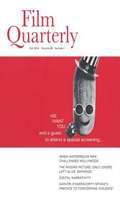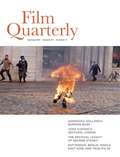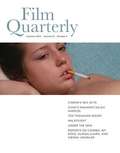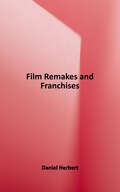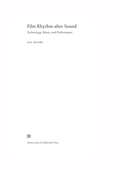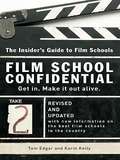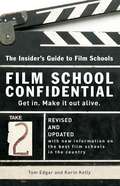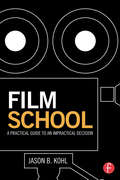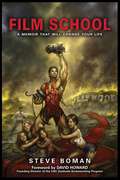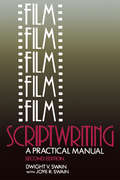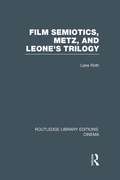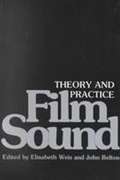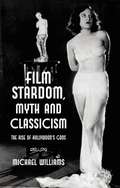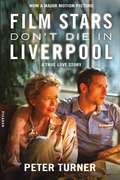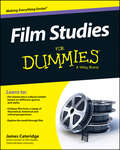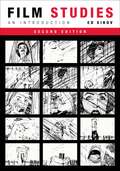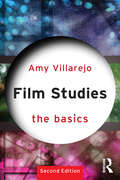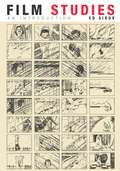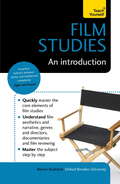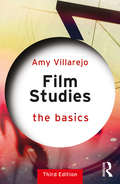- Table View
- List View
Film Programming: Curating for Cinemas, Festivals, Archives (Short Cuts)
by Peter BosmaThis study explores artistic choices in cinema exhibition, focusing on film theaters, film festivals, and film archives and situating film-curating issues within an international context. Artistic and commercial film availability has increased overwhelmingly as a result of the digitization of the infrastructure of distribution and exhibition. The film trade's conventional structures are transforming and, in the digital age, supply and demand can meet without the intervention of traditional gatekeepers—everybody can be a film curator, in a passive or active way. This volume addresses three kinds of readers: those who want to become film curators, those who want to research the film-curating phenomenon, and those critical cinema visitors who seek to investigate the story behind the selection process of available films and the way to present them.
Film Propaganda and American Politics: An Analysis and Filmography (Routledge Library Editions: Cinema #Vol. 4)
by James Combs Sara T. CombsOriginally published in 1994, this important book traces the rise of film propaganda in the 20th Century, discussing specifically how film can be used to manipulate public perception and opinions. Two distinct areas are covered: war propaganda, including feature and documentary films regarding warfare; and civilian propaganda, including films that address a variety of political subjects. Although the focus is American film and American politics, this book offers insights for all those interested in the affect of film on the minds of citizens of any country or state.
Film Quarterly Fall 2014
by B. Ruby RichFilm Quarterly has published substantial, peer-reviewed writing on cinema and media for nearly sixty years, earning a reputation as the most authoritative academic film journal in the United States, as well as an important English-language voice of cinema studies abroad.
Film Quarterly Spring 2014
by B. Ruby RichFilm Quarterly has published substantial, peer-reviewed writing on cinema and media for nearly sixty years, earning a reputation as the most authoritative academic film journal in the United States, as well as an important English-language voice of cinema studies abroad.
Film Quarterly Summer 2014
by B. Ruby RichFilm Quarterly has published substantial, peer-reviewed writing on cinema and media for nearly sixty years, earning a reputation as the most authoritative academic film journal in the United States, as well as an important English-language voice of cinema studies abroad.
Film Remakes and Franchises (Quick Takes: Movies and Popular Culture)
by Daniel HerbertContemporary media seems incredibly unoriginal, as Hollywood produces an endless flood of remakes, sequels, reboots, and franchises. We watch as the same stories, characters, and images appear again and again in different films, on new platforms, and as toys and other merchandise. Are these works simply crass commercial products, utterly devoid of creativity, or do they offer filmmakers a unique opportunity to reimagine iconic characters and modern myths? <p><p>Film Remakes and Franchises examines how remakes and sequels have been central to the film industry from its very inception, yet also considers how the recent trends toward reboots and transmedia franchises depart from those historical precedents. Film scholar Daniel Herbert not only analyzes the film industry's increasing reliance on recycled product but also asks why audiences are currently so drawn to such movies. In addition, he explores how contemporary filmmakers have used reboots and franchise movies to inject timely social commentary and diversity into established media properties. <p><p>A lively and accessible overview that covers everything from You've Got Mail to The Force Awakens, Film Remakes and Franchises raises essential questions about the intersection of business and creativity in Hollywood today.
Film Rhythm after Sound
by Lea JacobsThe seemingly effortless integration of sound, movement, and editing in films of the late 1930s stands in vivid contrast to the awkwardness of the first talkies. Film Rhythm after Sound analyzes this evolution via close examination of important prototypes of early sound filmmaking, as well as contemporary discussions of rhythm, tempo, and pacing. Jacobs looks at the rhythmic dimensions of performance and sound in a diverse set of case studies: the Eisenstein-Prokofiev collaboration Ivan the Terrible, Disney's Silly Symphonies and early Mickey Mouse cartoons, musicals by Lubitsch and Mamoulian, and the impeccably timed dialogue in Hawks's films. Jacobs argues that the new range of sound technologies made possible a much tighter synchronization of music, speech, and movement than had been the norm with the live accompaniment of silent films. Filmmakers in the early years of the transition to sound experimented with different technical means of achieving synchronization and employed a variety of formal strategies for creating rhythmically unified scenes and sequences. Music often served as a blueprint for rhythm and pacing, as was the case in mickey mousing, the close integration of music and movement in animation. However, by the mid-1930s, filmmakers had also gained enough control over dialogue recording and editing to utilize dialogue to pace scenes independently of the music track. Jacobs's highly original study of early sound-film practices provides significant new contributions to the fields of film music and sound studies.
Film School Confidential
by Tom EdgarEvaluates twenty-six film school programs in the United States, offers tips on the application and admission process, and includes comments from students and faculty.
Film School Confidential: An Insider's Guide to Film Schools
by Karin Kelly Tom EdgarThis completely revised edition of Film School Confidential continues to offer the inside scoop on every major film school program in the country. A must-have guide for students who are considering applying to film school, this book provides more than 20 profiles of the best film school programs across the country. Covering such key areas as curriculum, student body, reputation, and employment options for film school grads, the authors provide solid, objective information on each program as well as snippets from interviews with students and faculty members.
Film School: A Practical Guide to an Impractical Decision
by Jason B. KohlDevelop the tools you will need to succeed before, during, and after your film school education. Film School: A Practical Guide to an Impractical Decision is a specific, straightforward guide to applying, getting into, and thriving in film school and in the industry in general. Not only does this book appeal to both prospective and current film students, it also features an in depth discussion of the application process, both from the graduate and undergraduate perspectives. You will learn how to choose between different schools and programs, avoid debt, succeed at festivals, and transition out of film school and into the work world. Author Jason Kohl offers: Tips on how to develop your voice before attending film school A chronological layout that allows you to continually refer to the book throughout your film school process Advice on how to gauge the cost of attending film school Whether you are a recent film school graduate, or just starting the application process, Film School gives important advice and insider knowledge that will help you learn and grow in the film industry. Film School is a must-have for anyone who wants to know what it takes to succeed in film school and beyond.
Film School: A Practical Guide to an Impractical Decision
by Jason B. KohlDevelop the tools you will need to succeed before, during, and after your film school education. Film School: A Practical Guide to an Impractical Decision is a specific, straightforward guide to applying, getting into, and thriving in film school and in the industry in general. Not only does this book appeal to both prospective and current film students, it also features an in depth discussion of the application process, both from the graduate and undergraduate perspectives. You will learn how to choose between different schools and programs, avoid debt, succeed at festivals, and transition out of film school and into the work world. Author Jason Kohl offers: Tips on how to develop your voice before attending film school A chronological layout that allows you to continually refer to the book throughout your film school process Advice on how to gauge the cost of attending film school Whether you are a recent film school graduate, or just starting the application process, Film School gives important advice and insider knowledge that will help you learn and grow in the film industry. Film School is a must-have for anyone who wants to know what it takes to succeed in film school and beyond.
Film School: The True Story of a Midwestern Family Man Who Went to the World's Most Famous Film School, Fell Flat on His Face, Had a Stroke, and Sold a Television Series
by Steve BomanOne L meets You'll Never Eat Lunch in This Town Again In this comic and moving and completely true tale, Film School reveals what life is like at the elite school that trained Hollywood's biggest names. When Midwestern journalist Steve Boman applied to the University of Southern California's vaunted School of Cinematic Arts, the world's oldest and most prestigious film school, he had more than a few strikes against him: His wife was recovering from thyroid cancer. His beloved sister had just died of leukemia. He lost his job. He had three young children. He was in his late 30s…. And he had no experience in filmmaking. As Boman navigates his way through USC's arduous three-year graduate production program, he finds that his films fall flat, he's threatened with being kicked out of the program and he becomes the old guy no one wants to work with. Defeated, he quits and moves back to the Midwest to be with his family. After he is urged by his wife to reapply, he miraculously gets in for a second time...only to have a stroke on the first day of classes. But instead of doing the easy thing – running away again -- Boman throws caution to the wind and embraces the challenge. He slowly becomes a gray-haired Golden Boy at USC with films that sparkle. And then he does the impossible: While still in school, for a class project, he dreams up a television series that CBS catches wind of and develops into THREE RIVERS, a primetime Sunday night show. This story of challenge and triumph—and what it takes to make it in the world's most famous film school—is a must-read for anyone aspiring to become a Hollywood great or anyone just looking for a good story.
Film Scriptwriting: A Practical Manual
by Dwight V Swain Joye R SwainThis second edition of the widely acclaimed Film Scriptwriting is a truly practical manual for the working writer. It provides all the clear, step-by-step guidance you need to script both fact and feature film and video - from getting and developing ideas to the writing of master scene or shooting script. Featured in this new edition are annotated excerpts from some of today's most successful films, selected to point up principles and techniques discussed. Interviews with working film specialists reveal the things professional directors, producers, story editor, and analysts look for in appraising the scripts that come across their desks.
Film Semiotics, Metz, and Leone's Trilogy (Routledge Library Editions: Cinema)
by Lane RothSemiotics offers a systematic approach to analysing the stylistic structure of film. When this study was originally published in 1983 this was a recent addition to the methods of film study and it presents an explanation of film semiotics with direct application to comparative film research. It takes as its representative subject one trilogy of films and applies semiology, with careful textual analysis. The book begins with a basic introduction to semiotics and the ideas of Christian Metz on cinesemiotics. It then presents a syntagmatic analysis of each of the three Dollars films, with an outline of autonomous segments for each and a discussion of the findings before undertaking a wider analysis of the trilogy as a whole with commentary on the stylistic unity of the director’s work. This book, an enduring detailed study of these three films, also outlines clearly this method of classifying the formal structuring codes of film communication.
Film Sound: Theory and Practice
by Elisabeth Weis John Belton B. WeissThis classic anthology provides essential models for analyzing sound stylistics through the detailed study of critical sound films. Elisabeth Weis and John Belton carefully curate major essays from the world's most respected film historians, aestheticians, and theorists, including Douglas Gomery, Barry Salt, Rick Altman, Mary Ann Doane, S. M. Eisenstein, V. I. Pudovkin, René Clair, Béla Belázs, Siegfried Kracauer, Christian Metz, David Bordwell, Kristin Thompson, Noël Burch, and Arthur Knight. Their selections recount the innovations and triumphs of Ernst Lubitsch, Fritz Lang, Orson Welles, Alfred Hitchcock, Rouben Mamoulian, Dziga Vertov, Robert Bresson, Jean-Luc Godard, Robert Altman, and Francis Ford Coppola, among many others, and explicate the techniques and practices of sound filmmaking from initial recordings to final theater playback. Film Sound is the ideal companion for anyone seeking both a comprehensive introduction to the form and a rich survey of its historical and global evolution.
Film Stardom, Myth and Classicism
by Michael WilliamsSince the golden era of silent movies, stars have been described as screen gods, goddesses and idols. This is the story of how Olympus moved to Hollywood to divinise stars as Apollos and Venuses for the modern age, and defined a model of stardom that is still with us today.
Film Stars Don't Die in Liverpool: A True Love Story
by Peter TurnerSOON TO BE A MAJOR MOTION PICTURETHE GOLDEN AGE OF HOLLYWOOD, A YOUNG BRITISH ACTOR, A LOVE AFFAIR, AND A TRAGEDY, FILM STARS DON’T DIE IN LIVERPOOL IS THE TOUCHING STORY OF THE LAST DAYS OF A HOLLYWOOD ICON.On September 29, 1981, Peter Turner received a phone call that would change his life. His former lover, Hollywood actress Gloria Grahame, had collapsed in a Lancaster hotel and was refusing medical attention. He took her into his chaotic and often eccentric family’s home in Liverpool to see her through her last days. Though their affair had ended years before, it was to him that she turned in her final hour of need.Taking place over the course of three weeks in Turner’s larger-than-life working-class family home, Film Stars Don’t Die in Liverpool is an affectionate, moving, and wryly humorous memoir of friendship, love, and stardom.
Film Studies For Dummies
by James CateridgeMake sense of the world of cinema Want to pull back the curtain on film? This hands-on, friendlyguide unravels the complexities of film and helps you put cinemainto a cultural context. You'll get an easy-to-follow introductionto different film genres and styles, learn about the history ofcinema, get to know who makes up a filmmaking team, explore globalcinema from Hollywood to Bollywood and much more.Film Studies For Dummies will open your mind to how thefilm industry works and help you to discover the impact of film onpopular culture. You'll get easy-to-read information on analyzingand critiquing film from a range of theoretical, historical andcritical perspectives, and learn how people communicate ideas infilm. You'll also be able to shine a light on how stories aredeveloped in movies, understand how a storyline is related tobroader issues in society and become a well-versed and insightfulfilm student.Covers the narrative, artistic, cultural, economic andpolitical implications of cinemaProvides conceptual frameworks for understanding a film'srelationship to realityExplores how people tell stories and communicate ideas infilmHelps you excel as a student of filmWhether you're planning to study film, a humanities student witha forthcoming module on film or a film enthusiast wondering if thismight be the future for you, Film Studies For Dummies hasyou covered.
Film Studies, second edition: An Introduction (Film and Culture Series)
by Ed SikovFilm Studies is a concise and indispensable introduction to the formal study of cinema. Ed Sikov offers a step-by-step curriculum for the appreciation of all types of narrative cinema, detailing the essential elements of film form and systematically training the spectator to be an active reader and critic. He treats a number of fundamental factors in filmmaking, including editing, composition, lighting, the use of color and sound, and narrative. His description of mise-en-scene helps readers grasp the significance of montage, which in turn reveals the importance of a director’s use of camera movement.Film Studies is designed for courses on film history, film theory, and popular culture. Its straightforward explanations of core critical concepts, practical advice, and technical, visual, and aesthetic aspects anchor the reader’s understanding of the formal language and anatomy of film and the techniques of film analysis.The second edition of this best-selling textbook adds two new chapters: “Film and Ideology,” which covers how to read a film’s political and social content, and other key topics in film theory, and “Film Studies in the Age of Digital Cinema,” which explores the central problems of studying film when “film” itself is no longer the medium.
Film Studies: A Global Approach (The Basics)
by Amy VillarejoFilm Studies: The Basics is a compelling guide to the study of cinema in all its forms. This second edition has been thoroughly revised and updated to take account of recent scholarship, the latest developments in the industry and the explosive impact of new technologies. Core topics covered include: The history, technology and art of cinema Theories of stardom, genre and film-making The movie industry from Hollywood to Bollywood Who does what on a film set Complete with film stills, end-of-chapter summaries and a substantial glossary, Film Studies: The Basics is the ideal introduction to those new to the study of cinema.
Film Studies: An Introduction
by Ed SikovEd Sikov builds a step-by-step curriculum for the appreciation of all types of narrative cinema, detailing the essential elements of film form and systematically training the spectator to be an active reader and critic. Sikov primes the eye and mind in the special techniques of film analysis. His description of mise-en-scene helps readers grasp the significance of montage, which in turn reveals the importance of a director's use of camera movement. He treats a number of fundamental factors in filmmaking, including editing, composition, lighting, the use of color and sound, and narrative. Film Studies works with any screening list and can be used within courses on film history, film theory, or popular culture. Straightforward explanations of core critical concepts, practical advice, and suggested assignments on particular technical, visual, and aesthetic aspects further anchor the reader's understanding of the formal language and anatomy of film.
Film Studies: An Introduction
by Warren BucklandAn unpretentious guide for all those who want to learn to analyse, understand and evaluate films. Film Studies: An Introduction provides an overview of the key areas in film studies, including aesthetics, narrative, genre, documentary films and the secrets of film reviewing. From Hitchcock and Tarantino to Spielberg and Bigelow, you will gain a critical understanding of legendary directors and the techniques and skills that are used to achieve cinematic effects. Whether you are a film studies student or just a film buff wanting to know more, this book will give you an invaluable insight into the exciting and incredibly fast-moving world of film. Understand Film Studies includes: Chapter 1: Film aesthetics: formalism and realism Chapter 2: Film structure: narrative and narration Chapter 3: Film authorship: the director as auteur Chapter 4: Film genres: defining the typical film Chapter 5: The non-fiction film: five types of documentary Chapter 6: The reception of film: the art and profession of film viewingfilm viewing Teach Yourself titles employ the 'Breakthrough method', which is designed specifically to overcome problems that students face. - Problem: "I find it difficult to remember what I've read."; Solution: this book includes end-of-chapter questions and summaries, and flashcards of key points available on-line and as apps - Problem: "Most books mention important other sources, but I can never find them in time."; Solution: this book includes key texts and case studies are summarised, complete with fully referenced quotes ready to use in your essay or exam. - Problem: "Lots of introductory books turn out to cover totally different topics than my course."; Solution: this book is written by a current university lecturer who understands what students are expected to know.
Film Studies: An Introduction (Film and Culture Series)
by Ed SikovEd Sikov builds a step-by-step curriculum for the appreciation of all types of narrative cinema, detailing the essential elements of film form and systematically training the spectator to be an active reader and critic. Sikov primes the eye and mind in the special techniques of film analysis. His description of mise-en-scene helps readers grasp the significance of montage, which in turn reveals the importance of a director's use of camera movement. He treats a number of fundamental factors in filmmaking, including editing, composition, lighting, the use of color and sound, and narrative. Film Studies works with any screening list and can be used within courses on film history, film theory, or popular culture. Straightforward explanations of core critical concepts, practical advice, and suggested assignments on particular technical, visual, and aesthetic aspects further anchor the reader's understanding of the formal language and anatomy of film.
Film Studies: An Introduction: Teach Yourself
by Warren BucklandAn unpretentious guide for all those who want to learn to analyse, understand and evaluate films.Film Studies: An Introduction provides an overview of the key areas in film studies, including aesthetics, narrative, genre, documentary films and the secrets of film reviewing. From Hitchcock and Tarantino to Spielberg and Bigelow, you will gain a critical understanding of legendary directors and the techniques and skills that are used to achieve cinematic effects. Whether you are a film studies student or just a film buff wanting to know more, this book will give you an invaluable insight into the exciting and incredibly fast-moving world of film.Understand Film Studies includes:Chapter 1: Film aesthetics: formalism and realismChapter 2: Film structure: narrative and narrationChapter 3: Film authorship: the director as auteurChapter 4: Film genres: defining the typical filmChapter 5: The non-fiction film: five types of documentaryChapter 6: The reception of film: the art and profession of film viewing
Film Studies: The Basics (The Basics)
by Amy VillarejoA comprehensive overview of how to study film, this updated third edition provides concise and provocative summaries for approaching the language of film analysis, ways of thinking about film history, and approaches and methods for studying cinema, from national cinemas to genre to stardom and beyond. The new edition tracks the changes in film production and exhibition by situating the study of film within contemporary digital media cultures and structures, such as social media and streaming platforms. Without forsaking its emphasis on the study of film, the third edition updates its examples and provides fresh insight into today’s image culture. Film Studies: The Basics provides beginning students in film studies, as well as lifelong film buffs, with the tools to pursue film analysis, film history, and further inquiries into the medium.
